Vectors: Difference between revisions
No edit summary |
Msridhar30 (talk | contribs) No edit summary |
||
| Line 19: | Line 19: | ||
Improved by Ben Radak (Fall 2018) | Improved by Ben Radak (Fall 2018) | ||
In physics, a vector is a quantity with a magnitude and a direction. It helps determine the position of one point relative to another. | Improved by Megs Sridhar (Fall 2018) | ||
In physics, a vector is a quantity with a magnitude and a direction. It helps determine the position of one point relative to another. Vectors are utilized to describe quantities in a given space. In 2-space we see 2D images, correspondent of both x and y direction. In 3-space we identify 3D images, correspondent of an x, y, and z direction. | |||
==The Main Idea== | ==The Main Idea== | ||
| Line 154: | Line 156: | ||
Several other mathematicians developed similar vector systems to those of Bellavitis and Hamilton in the 19th century. The system used by Herman Grassman is the one that is most similar to the one used today. | Several other mathematicians developed similar vector systems to those of Bellavitis and Hamilton in the 19th century. The system used by Herman Grassman is the one that is most similar to the one used today. | ||
VPython was released by David Scherer in the year 2000. He came up with the idea after taking a physics class at Carnegie Mellon University. Previous programs only allowed for 2D modeling, so he took it upon himself to make something better. VPython, also known as Visual Python, allows for 3D modeling. | VPython was released by David Scherer in the year 2000. He came up with the idea after taking a physics class at Carnegie Mellon University. Previous programs only allowed for 2D modeling, so he took it upon himself to make something better. VPython, also known as Visual Python, allows for 3D modeling. | ||
== See also == | == See also == | ||
===External links=== | ===External links=== | ||
Mathematical Computations on Vectors: | |||
[http://ocw.mit.edu/courses/mathematics/18-02sc-multivariable-calculus-fall-2010/1.-vectors-and-matrices/part-a-vectors-determinants-and-planes/session-1-vectors/MIT18_02SC_notes_0.pdf] | [http://ocw.mit.edu/courses/mathematics/18-02sc-multivariable-calculus-fall-2010/1.-vectors-and-matrices/part-a-vectors-determinants-and-planes/session-1-vectors/MIT18_02SC_notes_0.pdf] | ||
Computational Work with Vectors: | |||
[http://vpython.org/contents/docs/vector.html] | [http://vpython.org/contents/docs/vector.html] | ||
Basics of Vectors: | |||
[https://www.physics.uoguelph.ca/tutorials/vectors/vectors.html] | [https://www.physics.uoguelph.ca/tutorials/vectors/vectors.html] | ||
Revision as of 14:05, 9 December 2018
Written by Elizabeth Robelo
Improved by Aparajita Satapathy
Improved by Lichao Tang
Improved by Jimin Yoon
Improved by Sabrina Seibel
Claimed: Sanjana Kumar Fall 2017
Improved by Audrey Suh (Spring 2018)
Improved by Heeva Taghian (Fall 2018)
Improved by Ben Radak (Fall 2018)
Improved by Megs Sridhar (Fall 2018)
In physics, a vector is a quantity with a magnitude and a direction. It helps determine the position of one point relative to another. Vectors are utilized to describe quantities in a given space. In 2-space we see 2D images, correspondent of both x and y direction. In 3-space we identify 3D images, correspondent of an x, y, and z direction.
The Main Idea
A vector [math]\displaystyle{ \vec A }[/math] is a quantity with a magnitude [math]\displaystyle{ |\vec A| }[/math] and a direction [math]\displaystyle{ \hat A }[/math]. The magnitude of a vector is a scalar quantity which represents the length of the vector but does not have a direction. A vector is represented by an arrow. The orientation of the vector represents its direction. The length of the vector represents its magnitude. When a vector is drawn, the starting point is the tail and the ending point is called the head, or the 'tip', of the vector. In physics, a vector always starts at the source and directs to the observation location. In other words, if you are drawing a vector, the tail of the vector will be located at the original location and the tip of the vector will be located at the observation location. Refer to the image below for a visual representation:
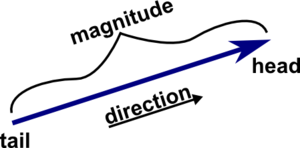
We can also add and subtract vectors. To add two vectors, place the head of one vector at the tail of the other. The sum vector will be the arrow starting from the tail of the first vector to the head of the second vector.
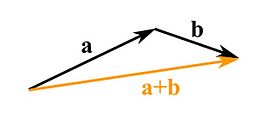
To subtract two vectors, reverse the direction of the vector you want to subtract and continue to add them like shown before.
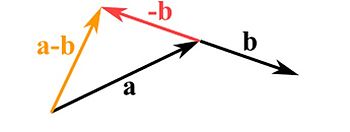
A vector can also be multiplied by a scalar. To multiply a vector by a scalar, we can stretch, compress, or reverse the direction of a vector. If the scalar is between 0 and 1, the vector will be compressed. If the scalar is greater than 1, the vector will get stretched. If the scalar has a negative sign, then the vector reverses its direction, even if it has also been compressed or stretched.
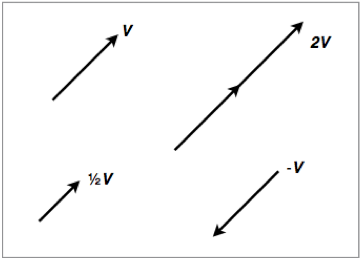
A Mathematical Model
Vectors are given by x, y, and z coordinates. They are written in the form [math]\displaystyle{ \lt X,\ Y,\ Z \gt }[/math] or [math]\displaystyle{ (X\ i + Y\ j + Z\ k) }[/math].
The following calculations can be performed on vectors:
Finding the Magnitude: [math]\displaystyle{ |\vec A| = \sqrt{x^2 + y^2 + z^2} }[/math]
Finding the Unit Vector: :[math]\displaystyle{ \hat{A} = \frac{\vec A}{|\vec A|} }[/math]
Dot Product: [math]\displaystyle{ |\vec A \cdot \vec B| = |\vec A| \ast |\vec B| \ast \cos\Theta }[/math]
Cross Product: [math]\displaystyle{ |\vec A \times \vec B| = |\vec A| \ast |\vec B| \ast \sin\Theta }[/math]
Adding Two Vectors: [math]\displaystyle{ \lt A_1,\ A_2,\ A_3 \gt + \lt B_1,\ B_2,\ B_3 \gt \ =\ \lt A_1 + B_1,\ A_2 + B_2,\ A_3 + B_3 \gt }[/math]
Multiplying Two Vectors: [math]\displaystyle{ \vec A \times \vec B = \lt A_1,\ A_2,\ A_3 \gt \times \lt B_1,\ B_2,\ B_3 \gt = \lt A_2 \ast B_3 - A_3 \ast B_2 \gt \ i\ +\ \lt A_1 \ast B_3 - A_3 \ast B_1 \gt \ j\ +\ \lt A_1 \ast B_2 - A_2 \ast B_1 \gt \ k }[/math]
Multiplying a vector and a scalar: [math]\displaystyle{ C\ \ast\ \lt A_1,\ A_2,\ A_3 \gt \ =\ \lt C \ast A_1,\ C \ast A_2,\ C \ast A_3 \gt }[/math]
[math]\displaystyle{ \vec A \cdot \vec B\ =\ \sum_{i=1}^n A_iB_i=A_1B_1+A_2B_2+\cdots+A_nB_n }[/math]
A Computational Model
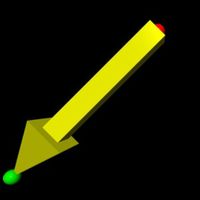
VIDLE is an interactive editor for VPython, a programming language that is commonly used in Physics to create 3D displays and animations. It is also used to perform iterative calculations using fundamental principles. Codes on VIDLE are instructions for a computer to follow to make these calculations.
In VIDLE code, arrow objects usually represent vector components. Arrows can be defined by their position, axis, and color. Each part can be manipulated to achieve different results. The position and axis of arrows are vectors, so they can be scaled by multiplying by a scalar. Arrows are often used to represent relative position vectors, starting at position A and ending at position B or by finding the "final minus initial" (B-A) position vector. In the image, the relative position vector is of the tennis ball with respect to the baseball, so the arrow points from the baseball to the tennis ball. If a relative position vector is in the 3D-plane, three further arrows can be used to denote the x, y, and z components. The z component vector is referenced using the formula vectorname.z.
In Physics 2, you will learn that a vector always starts at a source and points to the observation location at which physical quantities such as the electric or magnetic fields need to be found. Furthermore, it is important to be able to calculate the magnitude and direction of a vector in 3D space. Here is an example of a VPython model that computationally calculates such values. The green arrow represents the position vector which starts from a proton (red ball) to the arbitrary observation location. Click 'Run' on the upper-left corner in order to display the model.
--Htaghian3 (talk) 01:54, 16 September 2018 (EDT)
Examples
Simple
Which of the following statements is correct? (Can be more than one)
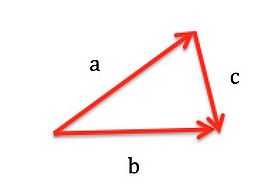
1. [math]\displaystyle{ \overrightarrow{c} = \overrightarrow{a} + \overrightarrow{b} }[/math]
2. [math]\displaystyle{ \overrightarrow{a} = \overrightarrow{b} - \overrightarrow{c} }[/math]
3. [math]\displaystyle{ \overrightarrow{a} = \overrightarrow{c} + \overrightarrow{b} }[/math]
4. [math]\displaystyle{ \overrightarrow{b} = \overrightarrow{c} + \overrightarrow{a} }[/math]
The answer is option number 2 and option number 4.
Intermediate
1. What is the magnitude of the vector C = A - B if A = <10, 5, 8> and B = <9, 4, 3>?
First we need to find the vector C: A - B = [math]\displaystyle{ \lt (10-9), (5-4), (8-3)\gt = \lt 1, 1, 5\gt = C }[/math]
[math]\displaystyle{ \sqrt{(1)^2 + 1^2 + 5^2} = 5.196 }[/math]
2. What is the cross product of A = <1,2,3> and B = <9,4,5>?
Use the equation for cross product: a x b= <a1, a2, a3> x <b1, b2, b3> = <a2*b3 - a3*b2> i - <a1*b3 - a3*b1> j + <a1*b2 - a2*b1> k
A x B[math]\displaystyle{ =\lt 2*5 - 3*4, 1*5 - 3*9, 1*4 - 2*9\gt = \lt -2, -22, -14\gt }[/math]
Difficult
What is the unit vector in the direction of the vector <10, 5, 8>? First you have to find the magnitude of the vector given: [math]\displaystyle{ \sqrt{10^2 + (5)^2 + 8^2} = 13.74 }[/math]
Finally divide the vector by its magnitude to get the unit vector:
[math]\displaystyle{ \tfrac{\lt 10, 5, 8\gt }{13.74} }[/math]
= <.727, .364, .582> Notice that the magnitude of the unit vector is equal to 1
Connectedness
1.Vectors will be used in many applications in most calculation based fields when movement and position are involved. Vectors can be two dimensional or three dimensional. Vectors are used to represent forces, fields, and momentum.
2.Vectors has been used in many application problems in engineering majors. In engineering applications, vectors are used to a lot of quantities which have both magnitude and direction. Dividing a magnitude into vector quantities in the x,y, and z directions clarify which components of a vector have quantity. For example, in Biomedical Engineering applications, vectors are used to represent the velocity of a flow to further calculate the flow rate and some other related quantities.
3. Vectors play a huge part in industry. For example, in process flow, vectors play a huge part in most calculations. For example, many calculations in different fields of science and math use vector components and direction. Our car's GPS uses vectors even if we don't realize it!
History
The discovery and use of vectors can date back to the ancient philosophers, Aristotle and Heron. The theory can also be found in the first article of Newtons Principia Mathematica. In the early 19th century Caspar Wessel, Jean Robert Argand, Carl Friedrich Gauss, and a few more depicted and worked with complex numbers as points on a 2D plane. in 1827, August Ferdinand published a book introducing line segments labelled with letters. he wrote about vectors without the name "vector".
In 1835, Giusto Bellavitis abstracted the basic idea of a vector while establishing the concept of equipollence. He called any pair of line segments of the same length and orientation equipollent (meaning equal length). He found a relationship and created the first set of vectors. Also in 1835 Hamilton founded "quaternions", which were 4D planes and equations with vectors.
William Rowan Hamilton devised the name "vector" as part of his system of quaternions consisting of three dimensional vectors.
Several other mathematicians developed similar vector systems to those of Bellavitis and Hamilton in the 19th century. The system used by Herman Grassman is the one that is most similar to the one used today.
VPython was released by David Scherer in the year 2000. He came up with the idea after taking a physics class at Carnegie Mellon University. Previous programs only allowed for 2D modeling, so he took it upon himself to make something better. VPython, also known as Visual Python, allows for 3D modeling.
See also
External links
Mathematical Computations on Vectors: [1]
Computational Work with Vectors: [2]
Basics of Vectors: [3]
Further Reading
Vector Analysis by Josiah Willard Gibbs
Introduction to Matrices and Vectors by Jacob T. Schwartz